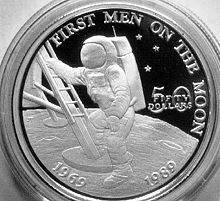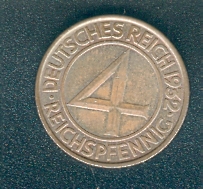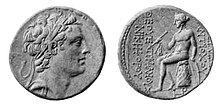collect coins
The collection of coins is both a hobby as well as from scientific operated interest. The scientific study of coins is called numismatics . Both course coins of a currency and commemorative coins that are specially produced as collectibles are collected.
Collecting areas
Coin collectors usually specialize in a certain subject area. It can be:
- a state
- a geographic region
- a historical epoch
- a special phenomenon in coinage like the Kipper coins in the Kipper and Wipper times
- a subject like FAO coins
- a coin motif such as B. Animal motifs
- Coins for certain occasions such as B. to the Olympic Games or the historical Saxon and Electoral Palatinate vicariate coins
- Coins made of certain materials such as B. bimetallic coins, earthenware coins, etc.
- Coins of a specific currency system such as B. Euro coins, coins from the Latin Union or Taler
- Reductions of coins that were customary for a new issue
- Coins with a minting error such as B. Hermaphrodite coins
In the field of coin collection , a distinction is also made between type collections , in which coins of the same motif, face value and metal appear only once, and year collections , in which attention is paid to completeness of all years for each type. Furthermore, it is possible to collect according to mint mark or to put together minor variants or incorrect mints of a coin.
Other collectors prefer commemorative coins in addition to course coins , which are issued on a wide variety of occasions.
Coin collectors are also often interested in related collectibles such as medals , tokens and banknotes .
Valuation
There are several factors that determine the value of a coin.
supply and demand
Supply and demand on the coin market play an important role. A low mintage often has a positive effect on the value of a coin, but demand also plays a decisive role. There are changing trends in coin collecting, which lead to sharp price swings up or down. Since 2002, for example, the current coin sets from the Vatican have been in great demand because many collectors have specialized in euro coins, and from a numismatic point of view these sets are not necessarily rare with a total circulation of around 100,000 per year (Germany, for example, issued 325,000 coin sets in 2013 ). The 25-euro bimetal coins from Austria with a mintage of 50,000 to 65,000 also achieve high market prices because they are in great demand with collectors because of their attractive appearance, without the mintage being particularly low. On the other hand, numerous states issue so many commemorative coins that even the smallest editions do not lead to an increase in value. For example, France has issued around 100 different commemorative coins per year since the introduction of the euro.
On the other hand, the number of coin collectors is declining due to demographics, so that prices have been falling overall since the 1990s, which affects almost all collecting areas. The decline in value was particularly drastic, for example, for the commemorative coins of the German Democratic Republic and the first five commemorative coins of the Federal Republic of Germany (5 DM), where the supply by dissolving collections clearly exceeds the market demand. Even older rarities, for example from the period between 1500 and 1800, which are mostly traded in auctions, tend to achieve falling prices.
The year and the mint of a coin may also have an influence on the price. For example, coins that are common in general can also contain rare years or mints with a corresponding price premium. The same applies to incorrect coins . The mint mark or the mint master mark can also be of considerable importance for the collector's value of a coin. In some cases, the signature on the coin is also of particular importance.
Many commemorative coins (especially from small states) that are distributed via newspaper advertisements and teleshopping tend to have the character of pseudo coins and are not subject to any increase in value.
Material value

The material value often plays a decisive role in coins made of precious metals (gold, silver, platinum and palladium), so many collectors have been able to benefit from the rise in commodity prices since 2003 and compensate for any losses due to generally falling prices on the coin market. With investment coins , the material value is in the foreground right from the start and these are held as an investment in the corresponding metal.
Degree of conservation
The degree of preservation also plays a major role. As a rule, coins from the 20th and 21st centuries are only collected in excellent or mint condition. Older coins are often many times more valuable in good condition than in poorer ones.
Age and history
In the case of ancient and medieval coins as well as primitive money, the age and history of a coinage also play a role. Nevertheless, the group of collectors in these areas is significantly smaller, as a high level of expertise is required to be able to distinguish originals from forgeries. That is why these pieces are usually only traded at specialized dealers and auctions. Last but not least, the variety of different coins is extremely large here, making a complete collection impossible. On the other hand, Roman coins are part of numerous excavations, especially in the Mediterranean region, and are therefore not a rarity per se; some finds from scientific excavations that have no museum relevance are also brought onto the market to cover part of the excavation costs.
Collect coins as an investment
Like vintage cars , art and antiques , a coin collection can also be viewed as a capital investment . On the one hand one can speculate on rising precious metal prices, on the other hand on a numismatic increase in value. A great deal of expertise is required for the latter, as particularly high-priced rarities have the potential to increase in value, although these are just as difficult to predict as other antiques. It should be noted that the number of coin collectors in the upper price segment has tended to decline since the 1990s. Modern coins are only suitable for this in individual cases, as they often “go out of style” after a few decades and prices then tend to fall.
Fakes
Counterfeits to the detriment of collectors have been around for a long time, especially (but not only) in the case of rarities, which is why very expensive pieces are often only traded with expert reports. Most of the mass counterfeits of modern coins (after 1800) come from China and are relatively easy to recognize due to some features. Fake silver coins are usually made of iron and are therefore - unlike the originals - magnetic. They also look “worn out”, but the small, deep scratches typical of silver coins that were actually in use are missing in the flat areas of the embossed image. Last but not least, the edge is often conspicuous: blunt on one side and sharp-edged on the other, the marginal writing is not in the middle of the edge, but slipped or the embossed image is not exactly centered. In addition, most counterfeit coins are minimally too small (diameter) and / or too light.
Well-known German counterfeits of Goldmark coins are the " Schmidt-Hausmann counterfeits" from around 1960.
cleaning

Many collectors are critical of the cleaning of coins. Cleaning in soapy water to remove dirt is usually unproblematic, especially with coins that have been in circulation for a long time or have been improperly stored. In addition, dipping baths for various metals are available in stores that have a deoxidizing effect and thus change the character of the coin. As a rule, gold coins and coins made of platinum do not need such cleaning, since gold and platinum hardly react with other substances in the environment anyway due to their chemical properties. Even on pure nickel coins there is usually no visible oxide layer. Silver, on the other hand, oxidizes over time and forms a gray to black patina , and it also loses its shine. By using a silver dip, the oxide layer is removed and the coin regains its bright shine. Silver dipping baths are still the most accepted among collectors and are used especially for modern coins of the 20th and 21st centuries. On the other hand, many collectors appreciate an even patina as a sign of the historical authenticity of a silver coin, which is why older silver coins should not be deoxidized.
Immersion baths for copper and bimetal coins are problematic because coins are not made of pure copper, but of a multitude of different alloys with the addition of different amounts of zinc , tin , aluminum or nickel and each alloy reacts differently to the bath. In addition, there is often a shine that is perceived as unnatural, which is known as "cat shine" and which differs significantly from the original embossed shine. In addition, coins can discolour or only lighten in some areas while remaining dark in others. In no case can the numismatic value of a coin be improved by dry cleaning. However, if a coin is disfigured as a result of an unsuccessful cleaning attempt, this significantly reduces its value.
Mechanical cleaning must be carried out with extreme care, as any scratches that may occur will reduce the value. Gold in particular is relatively soft and therefore very sensitive to shock. Soft paintbrushes and brushes or cotton swabs and the like that do not leave scratches are suitable for this.
storage
There are numerous different storage systems to protect coins from environmental influences. The most common of these are coin albums and coin boxes for collections and coin capsules and coin holders for individual pieces. Valuable coins should also be stored in a safe.
Transparent plastic sheets are stapled into a coin album, each of which can accommodate several coins on one side. The individual compartments in the foils have different sizes in order to optimally accommodate coins of any diameter. In the album, the coins can then be viewed from the front and back without touching them individually. Coin albums filled with coins should be stored in a lying position due to their heavy weight. A coin box is a box made of hard plastic, which is usually lined with velvet or felt and divided into square fields of equal size. A coin can then be inserted into each field. Due to their higher price and their larger space requirements, a coin cassette is particularly suitable for storing more valuable coins.
Capsules and frames are used to store individual items. Coin capsules consist of two round plastic shells that are inserted into one another and thus protect the coin in between. Frames consist of a piece of cardboard with two round recesses covered with foil. The coin is inserted, then the box is folded in the middle and then glued or stapled so that the frame surrounds the coin on both sides. Now the frame can be labeled, for example with catalog numbers, prices or information about the piece. While capsules can be opened and closed as often as desired, frames are intended for single use, as they cannot be opened again or are torn in the process. Capsules are especially used for commemorative coins and coins of the production type "Proof", while frames are used especially in the coin trade to price a piece and to display information about it.
Magazines
Individual evidence
- ↑ Der Spiegel of October 31, 1962
- ↑ Cleaning and caring for coins - tips and home remedies for all materials . In: sammlermuenzen.de . ( sammlermuenzen.de [accessed on November 16, 2017]).
literature
- Günter Schön / Gerhard Schön: World Coin Catalog 20./21. Century: 1900-2008 . 37th edition. Regenstauf 2008. ISBN 3866460368 .
- Dieter Fassbender : Lexicon for coin collectors , Verlag Battenberg, Augsburg 1996, ISBN 3-89441-334-4
- Dieter Fassbender: Collecting coins , Verlag Battenberg, 2002 2nd edition, ISBN 3-89441-526-6
- Horst Winskowsky: Maintaining coins , Verlag Battenberg, Augsburg 1993, ISBN 3-89441-152-X

